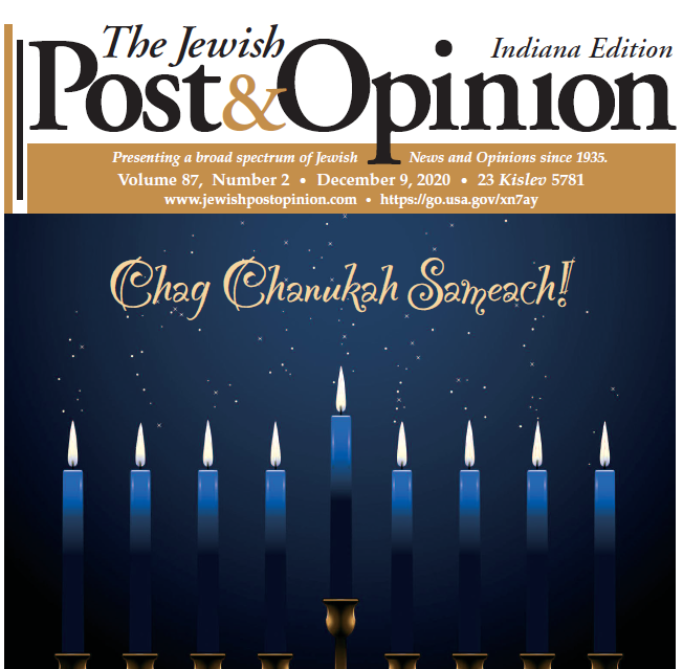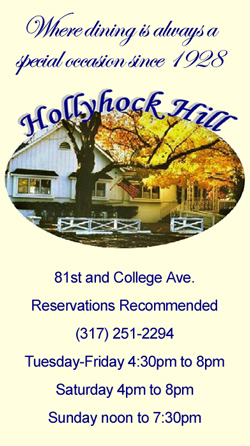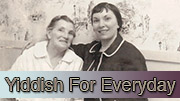By Miriam L. Zimmerman
A day in the life of a Holocaust educator: Jan. 28, 2014. Today, I must pick up Helen Farkas to take her to Mercy High School in San Francisco, where she will talk about her experiences in the Holocaust. Auschwitz survivor, speaker, and author of the memoir, Remember the Holocaust, at the age of 93, Helen continues to inspire students, their teachers, and anyone else privileged to hear her story. The program commemorates yesterday’s International Holocaust Remembrance Day.
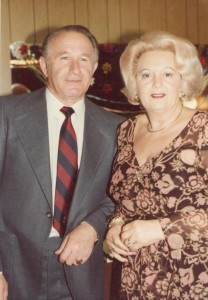
Joe and Helen Farkas 1990
Before I leave, I must adapt evaluation forms from a prior program for today’s presentation, prepare for tomorrow’s mediation for my day job as a divorce mediator, answer a myriad of emails, and check in with one of my daughters who is a new mom. I began writing this article at 7:20 a.m., after waking up my computer and feeding our flat-coated retriever, Sheba. First things first.
The Israeli Knesset (Israel’s Parliament) established Yom HaShoah Ve-Hagevurah, literally translated as “Day of (remembrance of) the Holocaust and the Heroism” on April 12, 1951, according to the Jewish Virtual Library. Yom HaShoah occurs on the 27th day of the Hebrew month of Nisan, midway between Passover and Yom Hazikaron, the Israeli Memorial Day for its fallen soldiers. It also marks the anniversary of the Warsaw Ghetto uprising, from April 19 to May 16, 1943.
The U.N. General Assembly proclaimed January 27 as International Holocaust Remembrance day on Nov. 1, 2005. Tied to the liberation of the largest Nazi extermination camp Auschwitz-Birkenau by Russian soldiers on Jan. 27, 1945, I remember the controversy in Jewish circles when the U.N. passed its resolution.
International Holocaust Remembrance Day on the anniversary of the liberation of a death camp, subtly reminds us of the “victimage” of the Jews. Inevitably, Auschwitz evokes images of gas chambers and piled bodies. Yom HaShoah, connected to the Warsaw Ghetto Uprising, subtly reinforces the heroism of the Jews. For this Holocaust educator, there cannot be too many Holocaust remembrance days, no matter what the point of reference. Both days provide opportunities for learning as well as remembrance.
To students enrolled in my Holocaust class at Notre Dame de Namur University, I note that the Warsaw Ghetto Uprising is the first armed resistance by Jews since the revolt of the Maccabees, in the year 164 BCE against the Greek tyrant Antiochus, which led to the miracle of Chanukah.
Parallels between the Warsaw Ghetto Uprising and the revolt of the Maccabees abound. Both the Nazis and Antiochus underestimated the power of spiritual resistance and had to call in additional troops. I emphasize to my students the youth of the leadership of the underground ghetto fighters, including 23-year-old Mordechai Anielewicz, who founded the Jewish Fighting Organization (Żydowska Organizacja Bojowa, “ŻOB”).
Today’s Israeli paper Haaretz online edition reports that both Poland and Germany held ceremonies of commemoration on Jan. 27. “Russian author Daniil Granin, 95, who was transported to Auschwitz in 1944 after surviving the Nazi siege of what was then Leningrad [now, St. Petersburg], was the keynote speaker in the Bundestag (German Parliament).”
Haaretz points out that “in addition to the 6 million Jews who were murdered by the Nazis, International Holocaust Remembrance Day also commemorates other victims of the Third Reich, including the mentally ill, homosexuals and Roma and Sinti.” Ever the educator, I need to point out that the Roma and Sinti are also known as “Gypsies,” a pejorative term best forgotten. Unfortunately, today’s students need this connection to understand who the Roma and Sinti are.
By 9:30 a.m., I finished breakfast and The Wall Street Journal. I could find no mention of Holocaust Remembrance Day in today’s edition. I wondered how the U.N. observed the day they instituted almost a decade ago. The U.N. News Centre online reported that on Jan. 27, 2014, the U.N. “paid tribute to the 6 million Jews and countless others massacred in the Nazi Holocaust with a solemn ceremony in the General Assembly Hall, a rebuke to Holocaust deniers, and a warning from Secretary-General Ban Ki-moon of the perils of anti-Semitism and hatred of any kind.”
Filmmaker Steven Spielberg delivered the keynote speech at the ceremony. His award-winning (seven Oscars) 1993 film, Schindler’s List, depicted the story of “a German businessman who saved over 1,000 mostly Polish-Jewish refugees during the Holocaust by employing them in his factories.” In my experience, few of today’s students have seen this important film. Spielberg “stressed that the world cannot emerge from the Holocaust until there are no more genocides, until the unthinkable becomes impossible….”
One of the Schindlerjuden (as those saved by Oscar Schindler came to be known), Rena Finder, shared her testimony at the U.N. “Encouraging young people to be more accepting of others and learn from the cruelty that was inflicted on Jews and other minorities during the Holocaust has been my life’s work,” she said.
The U.N. article concluded by describing “exhibitions at UN Headquarters under the theme ‘Remembrance Week: Journeys through the Holocaust,’ marking the 70th anniversary of the deportation of over half a million Jews from Hungary to the German Nazi death camps.”
How fitting to have a Hungarian Jew speaking at our Mercy High School commemoration on the 70th anniversary of the deportation of Hungarian Jews. I confess I had not made this connection. I almost forgot to adapt the evaluation form for today’s program at Mercy High School. I dashed out of the house just after 2 p.m. for my rendezvous at the Burlingame home of Helen Farkas.
Helen was ready and waiting for me, as I knew she would be. She has been speaking in schools since 1974. I realized in writing this column that it is the 40th anniversary of her Holocaust activism. During the ride to San Francisco, it was a pleasure to hear her describe her recent vacation with her daughter Amber, who lives in Hawaii. Since the weather was too bad to go swimming, she related that she spent a lot of time just “hanging out” with her family. I had to smile at the use of this term by a 93-year-old. Inclement weather or not, Hawaii is a long way from Auschwitz. Helen deserves many such vacations.
We arrived early for the 3:30 p.m. program. A half-dozen students were already seated in Mercy High School’s Rist Hall. Although sponsored by a consortium of organizations, the initiative for this program came from the Helen and Joe Farkas Center for the Study of the Holocaust in Catholic Schools at Mercy High School, San Francisco. As the interim volunteer director of the Farkas Center, I am proud that our organization has been the catalyst to bring together so many educators and their students.
The students kept arriving. By 3:20, no more empty chairs. Morgan Blum, Director of Education, Jewish Family and Children’s Services Holocaust Center and a Farkas Center Board member, invited entering students to come to the front where there was space for them to sit on the floor.
Masterfully, Morgan commanded their attention and introduced a video clip from a new film by the U.S. Holocaust Memorial Museum (USHMM), The Path to Nazi Genocide. I applaud her choice, having discovered this powerful 38-minute film last semester, and added it to my required WebQuest assignment for next year’s Holocaust class at Notre Dame de Namur University (NDNU). This important film is available on the USHMM website at: http://www.ushmm.org/learn/introduction-to-the-holocaust/path-to-nazi-genocide.
I mentally counted over 200 students and realized I hadn’t brought enough evaluation forms. Mercy teacher Kathy Curran, seated to my right, graciously printed more.
Morgan introduced Jim McGarry, founder of the Farkas Center. Jim has brought Holocaust survivors to Catholic schools for over 20 years. He and Helen go back at least that long. A 2010 article about Jim in Catholic San Francisco describes him as follows: “Since 1992, first at St. Ignatius College Preparatory, where he taught morality and social justice for 20 years, and for the last 10 years at Mercy High School, McGarry has brought before his students and full-school assemblies survivors who, in his words, are ‘exemplars for learning about conscience.’” Currently, Jim is the Director of the Sister Dorothy Stang Center for Social Justice and Community Engagement at NDNU.
Jim began by referencing the Peace Prayer of St. Francis, appropriate for an audience of primarily Catholic students. “Where there is despair, hope; Where there is darkness, light; And where there is sadness, joy.”
Jim introduced Helen by telling a story from a year and a half ago when he and his wife Kathy Curran accompanied Helen to Auschwitz, along with Morgan and Rabbi Peretz Wolf-Prusan, also a member of the Farkas Board. Morgan and Rabbi Peretz served as teachers on this pilgrimage. They were at the Grunewald Railroad Station in Berlin en route to Auschwitz to meet with students. The Grunewald Station was the major site of deportations of Berlin Jews, first to ghettos, then to the camps. It houses a Holocaust memorial.
Helen burst into tears. She said she knew it was not the station she took to Auschwitz. She explained to Jim and the others, “I am crying now, so that I can be strong for the students.” She was right; the students needed her to comfort them.
The students were writing their responses in journals in the silence of the grasslands where the barracks used to be in Birkenau, near the railway spur. Helen went to each of the students and put her arms around them. Each student cried with Helen individually.
Jim let Helen tell her story. For 45 minutes, Helen gave a first-person account of her experiences during the Holocaust to a rapt audience of students from eighth grade through high school seniors. Helen illustrated all the steps to genocide: normal family life before the Nazi occupation, rising discrimination and prejudice, relocation to a ghetto, and ultimately deportation to Auschwitz in a three-day cattle car ride by rail. The subsequent loss of her family on the ramp in Birkenau resonated with these students, many of whom referenced it on the evaluation forms. Helen found words to describe her experiences in the camp to convey the horror in terms the students could understand. She survived a death march and escaped by the help of an elderly woman.
Helen’s escape from the death march was the answer most often given to the question, “What was the most interesting part of the survivor’s story for you?” on the evaluation forms. The students retold Helen’s story in their own words on the forms, “Family and moments remembering the faces of [lost] loved ones.” “She swore she wouldn’t go back to her homeland but she did anyway.” “Honest/actual account made it real for me.” “About how Jewish people went to the Holocaust (it scared me).” “How she still remembers her mother; could tell she loved her a lot and still does.” “That she stayed strong throughout her imprisonment.” “It’s the part when her sister was separated from her little boy and never came back again.” “In the Q&A, she said she questioned God.”
Morgan wrapped up the Q&A so that the program ended as advertised, at 5:00 p.m. Students swarmed Helen. Some wanted their pictures taken with her; others wanted to purchase her memoir, Remember the Holocaust. Helen’s book is available on Amazon.com.
We did not leave until after 6:00 p.m. Helen was ready to get home. Rush hour traffic from San Francisco to the suburbs has reversed since I lived in the City over 40 years ago. The City has become a bedroom community for Silicon Valley. We sailed back to Burlingame with very little traffic, while cars returning to the City were bumper to bumper. Helen did not want me to walk her to her darkened front door, but I helped her anyway. We hugged good-bye and I returned home.
Home for me is San Mateo, one suburb south of Burlingame. I found my husband Richard holding our youngest granddaughter, Sarah Hannah, just six weeks old. Jealous of the baby, Sheba lay at his feet. It was my turn.
I held the sleeping baby for the next two hours, and gave her a bottle when she awakened. A rush came over me as I thought of Helen’s little nephew, disappearing with the throngs on the ramp in Birkenau, headed for the gas chamber.
After my daughter Rebecca picked up little Sarah, Richard and I watched President Obama’s State of the Union address to Congress on our DVR. I multitasked by sorting the 130 student evaluation forms. Students at today’s Holocaust Remembrance Day commemoration represented five Catholic and two public schools. They listed 24 different teachers.
Student responses are fascinating to this Holocaust educator. “It was interesting that the [newly arrived] women didn’t believe that the gas chambers existed.” “That all their hair was shaved.” “Her niece with polio – protecting her [in the camp].” “The detail she told her stories with.” “When Helen returned to her home, and ‘confronted’ her neighbors.” “All of it; it was interesting and sad to hear about a new perspective of the Holocaust.”
Helen’s story as repeated by the students on the forms: “The part of the camps and how they were set up and orderly.” “…how they were treated by the soldiers.” “How she was able to survive this tragedy.” “I liked how Helen explained that her father and his family would always find a way to be together eventually (after separations).” “Her description of the death march.” “How grateful she is that she came to America because ‘I feel like we complain a lot, but we are actually lucky to live here.’” “How multiple people in her family survived.” “That she ended up meeting her fiancé after the war, and they got married.”
Joe and Helen were married for 65 years, until his passing three years ago.
“She doesn’t hate humanity, but calls for love, tolerance.” At the end of her talk, Helen thus brought the proceedings full circle, back to the values expressed in the prayer of St. Francis.
As I drifted off to sleep around 11 p.m., I thought of the various International Holocaust Remembrance Day observances, from the United Nations in New York to Mercy High School in San Francisco. Whether it is a Steven Spielberg or a Jim McGarry who makes a survivor’s testimony available, spiritual resistance resonates with today’s students. “That she is still so brave.” On a deep primal level, it is one survivor, one student, and one story, which will make the unthinkable impossible.
Dr. Zimmerman is professor emerita at Notre Dame de Namur University (NDNU) in Belmont, Calif., where she continues to teach the Holocaust course. She can be reached at mzimmerman@ndnu.edu.
This article was originally published in our Feb. 5, 2014 National edition on page 10. https://jewishpostopinion.com/wp-content/uploads/2014/02/NAT_2-5-14F.pdf
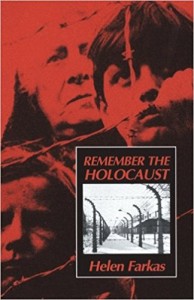
Memoir by Helen Farkas
